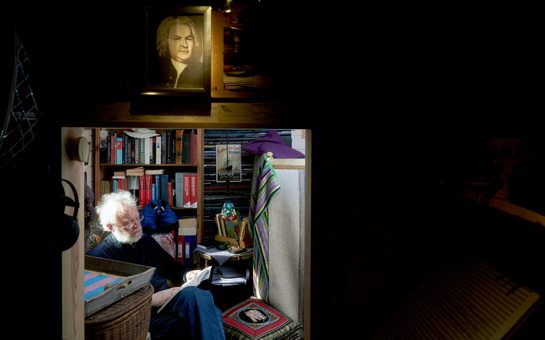- Poul Ruders
Symfoni nr. 5 (2013)
(Symphony no. 5)- Edition Wilhelm Hansen Copenhagen (World)
- 3(pic).3(ca).3(bcl)+cbcl.3(cbn)/4331/4perc/pf(cel)/str (16.14.12.10.8)
- 25 min
Programme Note
A composer today is supposed to produce not only a piece of music, but a so-called programme note as well, a text explaining what the whole thing is about, not unlike the short synopsis found on the backside of a novel. The great classical composers didn´t need to provide a programme note. When Brahms and his colleagues before him had a new composition in the offing, say a string quartet, a piano trio, even a symphony, everybody knew what to listen for, namely a piece of music about nothing but itself, following a time-honored tradition and well-established form.
With the advent of the tone poem at the second half of the 19th century and later on a multitude of new forms and ways, especially at the beginning of the 20th century, the music called for an explanatory text, making the subsequent “consumption of the merchandise” easier for the unprepared listener and here I am, in the middle of the second decade of the 21st century, having to explain what my Symphony No 5 is really about.
There´s no story, as it were, but I´ll admit that I initially wanted to give the piece a sub-title: Ring of Fire, inspired by the term used to describe the vast ring of active vulcanos encircling the Pacific basin. It sounds real good, right? – Ring of Fire – so naturally it´s been used before, more than once. I therefore gave up the idea and the symphony is the second of the series without a subtitle.The 4th symphony, the one featuring a concert organ, is quite simply called Symphony No 4: An organ symphony as opposed to Symphony and Transformation and Dream Catcher – the subtitles of my 2nd and 3rd symphonies.
At any rate, the Ring of Fire approach is dominant throughout the symphony.
The middle movement (there´re 3 movements) is an oasis of calm and patience ringed by two outer movements of speed and fury.
The first movement opens up introducing a tune of an almost endlessly self-reproducing nature riding at break-neck pace on the back of a, well, vulcano of orchestral activity and momentum. Formally the first movement is a rondo of sorts, with an easily recognizable section of flurrying figurations interrupting the tune in its track, only to disappear and then reappear in a slightly altered guise.
The third movement, the opposite half-crescent of fire, is less fast but more relentless in its vise-like, slow-burning endurance. The tune from the first movement makes a brief re-visit, and then – all of a sudden – its all over.
- Poul Ruders, October 2013
Media
Scores
Score preview
Reviews
Discography
More Info

- Poul Ruders’ symphonies collected in new box set
- 3rd October 2025
- New album release out on Bridge Records

- World Premiere of Poul Ruders' new symphony
- 12th November 2024
- Odense Symphony Orchestra presents the World Premiere of Poul Ruders' 'Symphony No.6'

 Located in the UK
Located in the UK
 Located in the USA
Located in the USA
 Located in Europe
Located in Europe